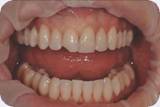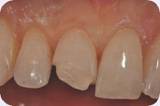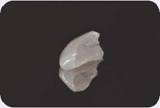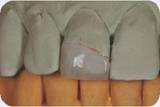
Management of a fractured central i ncisor I—mild
A common case of a fractured central incisor requiring a conservative (minimally invasive) Class IV partial porcelain laminate veneer is presented.
CASE STORY
A 23-year-old female presents to the dental office with a chief complaint of: “I chipped my front tooth and need it fixed.” She had a bonded restoration initially placed 4 years ago and replaced once, due to discoloration of the composite resin restoration. The patient reports that the restoration broke while eating cereal. She has inquired about “new materials” seeking a more “natural look.” For more information regarding anterior restorations, refer to Cases 12-15.
Figure 1: Pretreatment view.

Figure 2: Prepared right central incisor (8).

Figure 3: Porcelain laminate veneer.

Figure 4: Porcelain laminate veneer on the master cast.

Figure 5: Porcelain laminate veneer post cementation.

LEARNING GOALS AND OBJECTIVES
- Provide an aesthetic restoration using minimally invasive techniques.
- Discuss color matching
- Restore form, function, and aesthetics
- Care and maintenance for a porcelain laminate veneer(PLV)
Medical History
- Herpes labialis, since the age of 19
Dental History
- Good oral hygiene
- No restorative needs other than what is presented with right central incisor (8)
- Low caries index
Medications and Allergies
- Acyclovir as needed during the prodromal stage of a herpetic outbreak
- No known drug allergies
Review of Systems
- Vital signs:
- Blood pressure: 120/80
- Heart rate: 70 beats/minute
- Respiration rate: 16 breaths/minute
Social History
- Smoking: never smoked
- Alcohol: social drinker—”an occasional glass of wine”
- Recreational drugs: denies having ever used them
Extraoral Examination
- No significant findings
Soft Tissue Examination
- No significant findings
Clinical Findings/Problem List
- Class IV fracture of the maxillary right central incisor (8)
- Anterior aesthetics due to failed resin restoration on maxillary right central incisor (8)
Diagnosis
- Class IV dental fracture of maxillary right central incisor (8)
Clinical Decision-Making Determining Factors
- It is often preferable to provide an aesthetic result using minimally invasive techniques. The current evidence is that the veneered porcelain etched to intact and prepared enamel offers the advantages of increased strength, color stability, and aesthetics as compared to composite veneers (Garber 1989; Hui, Williams et al. 1991; Nordbo, Rygh-Thoresen et al. 1994; Zarone).
- The challenging aspects of anterior restorations are an accurate porcelain shade selection and communication of this critical color matching to the technician. There are many factors that affect shade selection. It has been described that the hydration of teeth can have a major impact on the shade selected. It typically takes natural teeth 10 minutes to dehydrate with a perceptible change in shade and up to 2 hours to rehydrate. It is therefore critical that shade selection is performed at the outset of treatment and prior to any tooth preparation or dehydration (Riley, Sanderson et al. 1986).
- The other factors that affect the shade selection include the presence of ambient daylight (Exner 1991) and shade selection technique. Newer data indicate that the spectrophotometric methods have a/>
Stay updated, free dental videos. Join our Telegram channel

VIDEdental - Online dental courses


